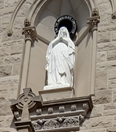Blog:Salvation is for the "childlike"? Matthew 11:25: Difference between revisions
Blog:Salvation is for the "childlike"? Matthew 11:25 (view source)
Revision as of 21:03, 9 August 2024
, 9 August→Confirmation bias
| Line 141: | Line 141: | ||
If we encounter a mystery without amazement, we have seen nothing. In the various Wikipedia entries on the Saints, our collected "wise and learned" authors fall back upon supposedly objective denials such as "some type of premonition"<ref>[[wikipedia:Siege_of_Orléans|Siege of Orléans - Wikipedia]]: "Joan's confessor / chaplain, Jean Pasquerel, later stated that Joan herself had some type of premonition or foreknowledge of her wound, stating the day before the attack that 'tomorrow blood will flow from my body above my breast.'"</ref>, "which are believed to have occurred in"<ref>[[wikipedia:Our_Lady_of_Guadalupe|Our Lady of Guadalupe - Wikipedia]]: "'''Our Lady of Guadalupe''' ... is a Catholic title of Mary, mother of Jesus associated with a series of five Marian apparitions to a Mexican peasant named Juan Diego and his uncle, Juan Bernardino, which are believed to have occurred in December 1531, when the Mexican territories were under the Spanish Empire."</ref>, and "witnesses who believed they had seen a miracle."<ref>[[wikipedia:Our_Lady_of_Fátima#Miracle_of_the_Sun|Our Lady of Fátima - Wikipedia]]: "Father John De Marchi, an Italian Catholic priest and researcher wrote several books on the subject, which included descriptions by witnesses who believed they had seen a miracle created by Mary, Mother of God."</ref> Worse, in the face of plain, first-hand historical witness, which somehow suffice as clear evidence for secular histories, the supposedly miraculous explanation is "not accepted by all authorities."<ref>[[wikipedia:Siege_of_Orléans|Siege of Orléans - Wikipedia]]: "Accordingly, when news of the defeat at Rouvray reached Vaucouleurs, Baudricourt became convinced of the girl's prescience and agreed to escort her. Whatever the truth of the story – and it is not accepted by all authorities – Joan left Vaucouleurs on 23 February for Chinon."</ref> | If we encounter a mystery without amazement, we have seen nothing. In the various Wikipedia entries on the Saints, our collected "wise and learned" authors fall back upon supposedly objective denials such as "some type of premonition"<ref>[[wikipedia:Siege_of_Orléans|Siege of Orléans - Wikipedia]]: "Joan's confessor / chaplain, Jean Pasquerel, later stated that Joan herself had some type of premonition or foreknowledge of her wound, stating the day before the attack that 'tomorrow blood will flow from my body above my breast.'"</ref>, "which are believed to have occurred in"<ref>[[wikipedia:Our_Lady_of_Guadalupe|Our Lady of Guadalupe - Wikipedia]]: "'''Our Lady of Guadalupe''' ... is a Catholic title of Mary, mother of Jesus associated with a series of five Marian apparitions to a Mexican peasant named Juan Diego and his uncle, Juan Bernardino, which are believed to have occurred in December 1531, when the Mexican territories were under the Spanish Empire."</ref>, and "witnesses who believed they had seen a miracle."<ref>[[wikipedia:Our_Lady_of_Fátima#Miracle_of_the_Sun|Our Lady of Fátima - Wikipedia]]: "Father John De Marchi, an Italian Catholic priest and researcher wrote several books on the subject, which included descriptions by witnesses who believed they had seen a miracle created by Mary, Mother of God."</ref> Worse, in the face of plain, first-hand historical witness, which somehow suffice as clear evidence for secular histories, the supposedly miraculous explanation is "not accepted by all authorities."<ref>[[wikipedia:Siege_of_Orléans|Siege of Orléans - Wikipedia]]: "Accordingly, when news of the defeat at Rouvray reached Vaucouleurs, Baudricourt became convinced of the girl's prescience and agreed to escort her. Whatever the truth of the story – and it is not accepted by all authorities – Joan left Vaucouleurs on 23 February for Chinon."</ref> | ||
I think the purposes of the interested parties that govern certain Wikipedia pages is clear. Yet, we fool ourselves to think that we ourselves would never have been skeptical like the pharisees, or, had we been there ourselves, that we'd be entirely free of doubt. Most doubtful. | I think the purposes of the interested parties that govern certain Wikipedia pages is clear. Yet, we fool ourselves to think that we ourselves would never have been skeptical like the pharisees, or, had we been there ourselves, that we'd be entirely free of doubt. Most doubtful.<ref>Jesus tells the pharisees | ||
“Woe to you, scribes and Pharisees,* you hypocrites. You build the tombs of the prophets and adorn the memorials of the righteous,30n and you say, ‘If we had lived in the days of our ancestors, we would not have joined them in shedding the prophets’ blood.’31o Thus you bear witness against yourselves that you are the children of those who murdered the prophets" (Mt 23:29)</ref> | |||
You may have seen the "dancing bear" or "invisible gorilla" videos, short films of groups of people running in circles passing around a basketball.<ref>Here for the bear: https://www.youtube.com/watch?v=UfA3ivLK_tE ; and here for the gorilla: http://www.youtube.com/watch?v=vJG698U2Mvo</ref> When told to count how many times the ball has been passed around, viewers fail to see amidst the shuffle either a moon-walking bear or a gorilla going right through the group. Called "selective attention," it's really a form of ''confirmation bias'', whereby we see what we expect to see, we believe only what we already believe. | You may have seen the "dancing bear" or "invisible gorilla" videos, short films of groups of people running in circles passing around a basketball.<ref>Here for the bear: https://www.youtube.com/watch?v=UfA3ivLK_tE ; and here for the gorilla: http://www.youtube.com/watch?v=vJG698U2Mvo</ref> When told to count how many times the ball has been passed around, viewers fail to see amidst the shuffle either a moon-walking bear or a gorilla going right through the group. Called "selective attention," it's really a form of ''confirmation bias'', whereby we see what we expect to see, we believe only what we already believe. | ||
